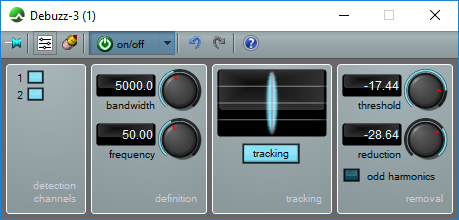Debuzz

The family of degradations known as buzzes includes many audio phenomena that are characterised by having a large number of strong, closely spaced harmonics. Traditional comb filters will remove these, but the side effects of echo and a strongly coloured hollow nature are unacceptable. Alternatively you could use a cascade of high-Q parametric filters, but the number of harmonics generally makes the setup time impractical. Furthermore, these traditional techniques cannot adapt to variations in the buzz's fundamental frequency and they will always damage any signal that coincides with its harmonics.
The Debuzz-3 algorithm is our best yet. It provides full-bandwidth processing, removing components across the entire audio spectrum, and it is capable of removing all manner of buzzes and hums with fundamental frequencies as high as 500Hz. Compared with earlier algorithms, it offers improved signal modelling and better component tracking. Having locked on to the fundamental, it even has the ability to cope with jittery buzzes. Typically, Debuzz-3 will successfully remove the buzz even if the frequency drifts by as much as 2% at 50Hz at 44.1kHz sample rate.
The module also rescues signal that lies at the same frequencies as the buzz harmonics. It does this by analysing the dynamics of the signal and buzz, optimally detecting and reducing the buzz with minimal side effects. What's more, the Odd Harmonics option eliminates processing at the even harmonic frequencies. This ensures that no unnecessary processing occurs if the buzz comprises odd harmonics, resulting in even less chance of damage to the genuine signal.
With controls to limit the processing bandwidth (and therefore improve selectivity), to limit detection and processing to the channels of your choosing, and to control the detector and amount of buzz removed, Debuzz-3 is a remarkably powerful tool. There's even a confidence meter that allows the system to tell you whether the chosen frequency is, in fact, the true fundamental of the buzz or hum. What's more, Debuzz-3 also takes advantage of CEDAR's unique Markers that let you transfer frequency information between CEDAR Cambridge processes. This is of huge benefit when using the Spectrum Analyser (with its 0.02Hz resolution) to detect unwanted fundamentals and their harmonics.